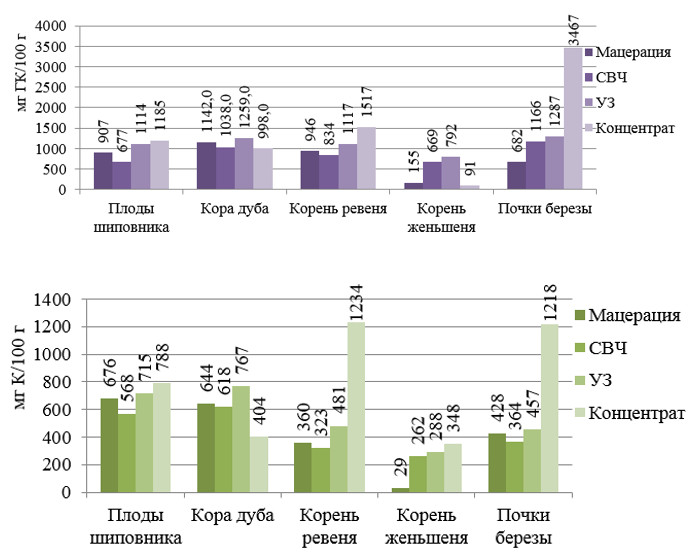INFLUENCE OF EXTRACTION TECHNOLOGY ON THE CONTENT OF PHENOLS, FLAVONOIDS AND ANTIOXI-DANT ACTIVITY FOR HIPS (ROSA L.), OAK BARK (QUERCUS ROBUR L.), ROOT RHENA (RHEUM OFFICINALE), GINSENG ROOT (PANAX L.), KIDNEY BIRCH (BETULA L.)
UDC 664.5
Abstract
Plant materials have huge untapped potential in Russia. It has potential antioxidant properties, contains a large number of biologically active substances. As a result of a comparative study of the content of phenols, flavonoids, anti-radical ability according to the method with 2,2'-diphenyl-1-picrylhydrazyl reagent, restoring forces according to FRAP method with 2,4,6-tri (2-pyridyl)-1,3 reagent, 5-triazine in extracts obtained by three different extraction technologies (maceration 37 °C for 2 hours, microwave irradiation 800 W 1 min, ultrasonic treatment 37 °C, 37 kHz 90 min) from plant materials: rosehips (Rosa L.), oak bark (Quercus robur L.), rhubarb root (Rheum officinale), ginseng root (Panax L.), birch buds (Betula L.) on the advantage in the level of the studied indicators for the technology of extracts using innovative effects – ultrasonic irradiation. Extracts of plant materials are potential sources of antioxidant substances and can be used in the pharmaceutical, cosmetic industry and as components of food systems. A general trend is observed, which was observed in the study of various indicators: concentrated extracts, in which phenolic compounds and flavonoids are preserved after concentration (rhubarb root extract and birch bud extract), exhibit the best antiradical activity and restoring power; then, as with their destruction, other indicators fall.
Downloads
Metrics
References
Cannavó S.P., Tonacci A., Bertino L., Casciaro M., Borgia F., Gangemi S. Pathology – Res. and Practice, 2019, vol. 215, pp. 21–28. DOI: 10.1016/j.prp.2018.11.020.
Sáez-Freire M., Blanco-Gómez A., Castillo-Lluva S. Free Radical Biol. and Med., 2018, vol. 120, pp. 133–146. DOI: 10.1016/j.freeradbiomed.2018.03.012.
Neha K., Haider M.R., Pathak A., Yar M.Y. Eur. J. Med. Chem., 2019, vol. 178, pp. 687–704. DOI: 10.1016/j.ejmech.2019.06.010.
Ibrahim E.A., Baker D.H.A., El-Baz F.K. Int. J. Pharm. Sci. Rev. Res., 2016, vol. 39, no. 17, pp. 93–99.
Ashnagar A., Naseri N.G., Nasab H.H. ECJHAO, 2007, vol. 4, no. 4, pp. 546–549. DOI: 10.1155/2007/620396
Hamad A.M.A. Int. J. Sci. and Technol. Res., 2019, vol. 8, no. 3, pp. 93–98.
Vedernikov D.N., Roshchin V.L. Russ. J. Bioorg. Chem., 2012, vol. 38, no. 7, pp. 753–761. DOI: 10.1134/S1068162012070217.
Metwaly A.M., Lianlian Z., Luqi H., Deqiang D. Molecules, 2019, vol. 24, p. 1856. DOI: 10.3390/molecules24101856
Cho Ch.-W., Kim Y.-Ch., Rhee Y.K., Lee Y.-Ch., Kim K.-T. J. Ethnic Foods, 2014, vol. 1, pp. 24–28. DOI: 10.1016/j.jef.2014.11.007.
Mármol I., Sánchez-de-Diego C., Jiménez-Moreno N., Ancín-Azpilicueta C., Rodríguez-Yoldi M.J. Int. J. Mol. Sci., 2017, vol. 18, p. 1137. DOI: 10.3390/ijms18061137.
Taneva I., Petkova N., Dimov I., Ivanov I., Denev P. J. Pharmac. and Phytochem., 2016, vol. 5, no. 2, pp. 35–38.
Elnour A.A.M., Mirghani M.E.S., Musa K.H., Kabbashi N.A., Alam M.Z. Health Sci. J., 2018, vol. 12, no. 5, p. 596. DOI: 10.21767/1791-809X.1000596.
Xu D.-P., Li Y., Meng X., Zhou T., Zhou Y., Zheng J., Zhang J.-J., Li H.-B. Int. J. Mol. Sci., 2017, vol. 18, p. 86. DOI: 10.3390/ijms18010096.
Vázquez-Espinosa M., Espada-Bellido E., de Peredo A.V.G., Ferreiro-González M., Carrera C., Palma M., Barro-so C.G., Barbero G.F. Agronomy, 2018, vol. 8, p. 240. DOI: 10.3390/agronomy8110240.
Li Y., Li Sh., Lin Sh.-J., Zhang J.-J., Zhao C.-N., Li H.-B. Molecules, 2017, vol. 22, p. 1481. DOI: 10.3390/molecules22091481.
Sahin S. Trakya Univ. J. Nat. Sci., 2018, vol. 19, no. 2, pp. 121–128. DOI: 10.23902/trkjnat.344985.
Aguilar-Hernández G., García-Magaña M.L., Vivar-Vera M.A., Sáyago-Ayerdi S.G., Sánchez-Burgos J.A., Morales-Castro J., Anaya-Esparza L.M., González E.M. Molecules, 2019, vol. 24, p. 904. DOI: 10.3390/molecules24050904
Ramón-Gonçalves M., Gómez-Mejfa E., Rosales-Conrado N., León-González M.E., Madrid Y. Waste Manag., 2019, vol. 96, pp. 15–24. DOI: 10.1016/j.wasman.2019.07.009.
Hamed Y.S., Abdin M., Akhtar H.M.S., Chen D., Wan P., Chen G., Zeng X. South Afr. J. Bot., 2019, vol. 124, pp. 270–279. DOI: 10.1016/j.sajb.2019.05.006.
Politi F.A.S., Queiroz-Fernandes G.M., Rodrigues E.R., Freitas J.A., Pietro R.C.L.R. Micr. Pathogen., 2016, vol. 95, pp. 15–20. DOI: 10.1016/j.micpath.2016.02.016.
Aruwa C.E., Amoo S.O., Kudanga T. South Afr. J. Bot., 2019, vol. 125, pp. 402–410. DOI: 10.1016/j.sajb.2019.08.007
Bayir A.G., Aksoy A.N., Koçyiğit A. Bezmialem Sci., 2019, vol. 7, no. 2, pp. 157–163. DOI: 10.14235/bas.galenos.2018.2486.
Hayat M., Abbas M., Munir F., Hayat M.Q., Keyani R., Amir R. J. Biomol. Biochem., 2017, vol. 1, no. 1, pp. 12–17.
Kumar S., Pandey A.K. Brit. J. Med. & Med. Res., 2015, vol. 7, no. 6, pp. 438–457. DOI: 10.9734/BJMMR/2015/16284.
Breitenbach M., Eckl P. Biomolecules, 2015, vol. 8, pp. 1169–1177. DOI: 10.3390/biom5021169.

Copyright (c) 2020 chemistry of plant raw material

This work is licensed under a Creative Commons Attribution 4.0 International License.

This work is licensed under a Creative Commons Attribution 4.0 International License.
The authors, which are published in this journal, agree to the following conditions:
1. Authors retain the copyright to the work and transfer to the journal the right of the first publication along with the work, at the same time licensing it under the terms of the Creative Commons Attribution License, which allows others to distribute this work with the obligatory indication of the authorship of this work and a link to the original publication in this journal .
2. The authors retain the right to enter into separate, additional contractual agreements for the non-exclusive distribution of the version of the work published by this journal (for example, to place it in the university depository or to publish it in a book), with reference to the original publication in this journal.
3. Authors are allowed to post their work on the Internet (for example, in a university repository or on their personal website) before and during the review process of this journal, as this may lead to a productive discussion, as well as more links to this published work.











